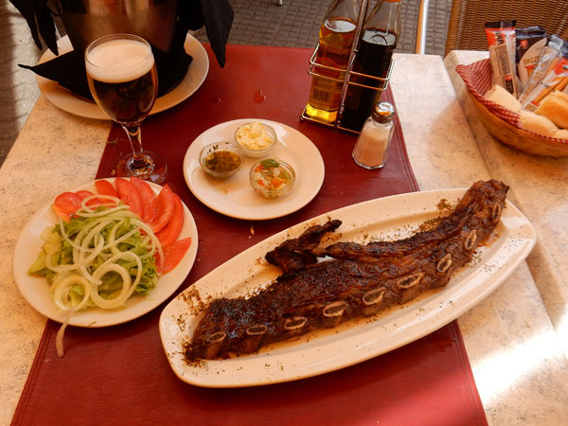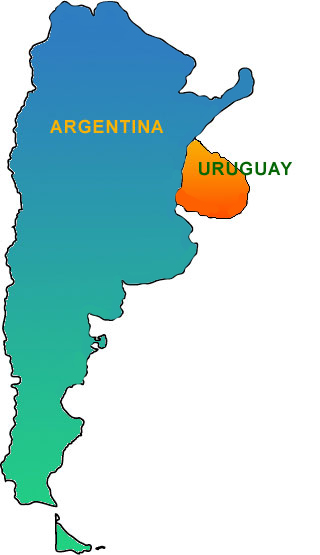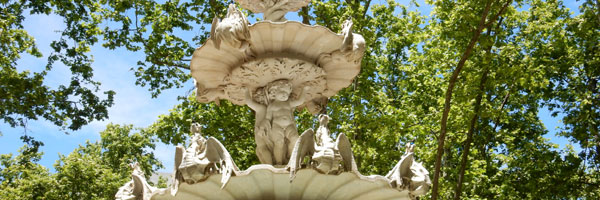A Trip to Another Country
I got up extremely early this morning, taking off for a big all-day adventure. I'm in a different world now from Buenos Aires, a different city, a different country. I'm sitting in the Plaza Zabala, in the heart of the Ciudad Vieja (Old City) of Montevideo, Uruguay. I crossed the Rio de la Plata this morning on a high-speed hydrofoil ferryboat, a journey of 200 kilometers that took just over two hours.
I arrived at the port of Montevideo around 10:00 in the morning and set out to explore the city. But my first task was to find my morning café con leche. The port is just a short walk away from the Ciudad Vieja, so I quickly found a nice café at the Mercado del Puerto where I could spend some time and enjoy the morning. It was a great place to watch the people of Montevideo, walking through the quiet early morning streets of the city.
After breakfast, I began my explorations, wandering aimlessly through the narrow streets, taking in the beautiful colonial architecture. The Ciudad Vieja of Montevideo is located on a small peninsula that juts out into the Rio de la Plata, which makes it easy to get oriented to the city. A small hill runs along the center of the peninsula, so at each intersection, the waterfront is visible down below, sometimes in several directions. I walked up to the Plaza Zabala, the first of three plazas that link the old city together. Plaza Zabala is graced with a grand equestrian statue of Don Bruno de Zabala, the founder of the city of Montevideo.
From Plaza Zabala, I continued to wander the narrow streets of the old city, taking Calle Washington to the next plaza a few blocks away. Plaza Constitución is a little bigger and more grandiose than Plaza Zabala, and it was here that the old colonial city came to be centered. Plaza Constitución has an ornate fountain at its center and an air of dignified grace.
I arrived at the plaza just before noon, right on time to watch the changing of the guard outside the Cabildo, the onetime headquarters of the Virreinato del Río de la Plata (Viceroyalty of the River Plate). A marching band heralded the event, dressed in full regalia and filling the plaza with a brass cacophony. I asked one of the onlookers if this was a special holiday, but he told me it was a daily event, part of the ritual of Montevideo.
I followed the marching band down Calle Sarandí and came to the next plaza in a few blocks. This was Plaza de la Independencia, which was even bigger and grander than Plaza Constitución. This was clearly the civic center of the nation, with a massive equestrian statue of José Gervasio Artigas, the Uruguayan hero of the struggle for independence from Spain.
At the far end of the Plaza de la Independencia is a highrise building that looked very familiar. It is the Palacio Salvo, the "twin building" of the Palacio Barolo in Buenos Aires, designed by the same architect, Mario Palanti. I walked around the plaza, heading over to the Teatro Solís, the oldest theater in Uruguay, dating back to 1856. I stopped to talk to a couple of elderly Chilean women, who asked me to take a photo of them in front of the theater. I told them about my travels in Chile and they told me about their travels in Uruguay and Argentina.
I continued my wanderings around Montevideo, heading down to the waterfront, which was graced by the seaside Rambla Gran Britania and Rambla Francia. I walked along these grand seaside parks, watching the waves wash in from the Rio de la Plata. A fisherman stood out on the rocks, casting his line into the muddy waters of the river. It was here that I really thought that this was more of a bay than a river; I couldn't see the other side but I knew Argentina was out there, beyond the vast waterway.
I made my way around the waterfront, and then back up the hill into the Ciudad Vieja. I stopped at the Museum of Natural History, a small but charming museum that displayed the indigenous story of Uruguay. I wandered through the exhibits, taking in a mix of anthropology, art, and photography.
By the time I left the museum it was late afternoon and my appetite was strong. I went back to the Mercado del Puerto on the waterfront and found a restaurant where I could enjoy an Asado, the national dish of Uruguay. I sat in an outdoor café and sipped a beer, then sat back to savor the biggest steak I had ever seen. I was afraid the table was going to collapse when the waiter put the plate in front of me, a long rack of ribs lined with tender delicious steak. A salad and a plate of garnishes completed the meal, a long slow experience of taking in the flavor of Uruguay.

After my late lunch, I caught the 7:30 boat back to Buenos Aires. I arrived in the port late at night, exhausted but happy after a long day in another country. I took a taxi back to San Telmo and really appreciated the fast recklessness of the driver, speeding down the grand boulevards of Buenos Aires and getting me back home in just 10 minutes. I knew I had another big day ahead of me, taking on the next phase of my trip to Argentina.
| Next up: Off to Patagonia
|


© 2016 Michael Hanrahan